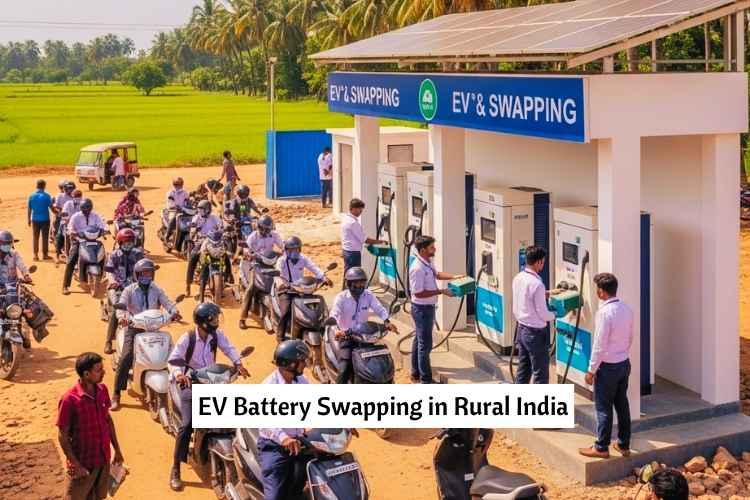EV Battery Swapping in Rural India: As India strides towards a sustainable future, electric vehicles (EVs) are becoming increasingly central to its transportation landscape. While urban areas have witnessed a surge in EV adoption, rural regions are gradually catching up, particularly in the two-wheeler segment. A pivotal development facilitating this transition is the advent of battery swapping technology. This article delves into the nuances of EV battery swapping in rural India, exploring its potential to revolutionise two-wheeler adoption by 2025.

Table of Contents
EV Battery Swapping in Rural India: Understanding Battery Swapping

Battery swapping is an innovative solution where depleted batteries in EVs are exchanged for fully charged ones at designated stations. This method eliminates the downtime associated with traditional charging, allowing riders to resume their journeys within minutes. For rural areas, where charging infrastructure may be sparse, battery swapping offers a practical alternative to ensure uninterrupted mobility.
The Rural Imperative for Battery Swapping
Rural India presents unique challenges and opportunities for EV adoption:
- Infrastructure Limitations: Many rural areas lack the robust electrical infrastructure required for widespread charging stations.
- Affordability Concerns: The high upfront cost of EVs, primarily due to battery expenses, can be prohibitive for rural consumers.
- Operational Efficiency: For rural delivery services and daily commuters, minimising vehicle downtime is crucial.
Battery swapping addresses these concerns by reducing initial costs (as batteries can be leased or subscribed to), circumventing the need for extensive charging infrastructure, and ensuring quick turnaround times for vehicles.
Challenges to Overcome
Despite its promise, battery swapping faces several hurdles:
- Standardisation Issues: Lack of uniform battery sizes and connectors across different EV manufacturers hampers interoperability.
- High Initial Investment: Setting up swapping stations requires significant capital, which can be a deterrent for widespread deployment in rural areas.
- Consumer Awareness: Educating rural populations about the benefits and usage of battery swapping is essential for adoption.
Conclusion
Battery swapping stands as a beacon of hope for accelerating EV adoption in rural India. By addressing infrastructure challenges, reducing costs, and enhancing operational efficiency, it paves the way for a sustainable and inclusive transportation future. With concerted efforts from stakeholders across the spectrum, 2025 could mark a significant milestone in India’s journey towards electrified rural mobility.
Bhakti Rawat is a Founder & Writer of InsureMyCar360.com. This site Provides You with Information Related To the Best Auto Insurance Updates & comparisons. 🔗
